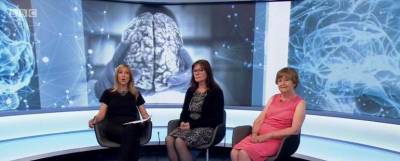Banking Britain's brains: the story of a scientific resource
3 August 2016
Dr Tammaryn Lashley, Alzheimer's Research UK Senior Research Fellow, UCL Institute of Neurology, was interviewed on the Victoria Derbyshire show this week, discussing the work of brain banks such as the Queen Square Brain Bank.
Excerpt from an article on the BBC website:
Every year, hundreds of human brains are delivered to a network of special research centres. Why do these "brain banks" exist and what do they do?
The BBC were recently given rare access to the Bristol Brain Bank, and filmed their work
there.
This film was shown on the Victoria
Derbyshire show this week, followed by the interview with Dr Tammaryn Lashley.
Dr Tammaryn Lashley interviewed on Victoria Derbyshire. Image courtesy of BBC.
These brain banks are two of 10 centres that make up the Medical Research Council's Brain Banks Network.
Between them annually they supply tens of thousands of samples of research tissue to scientists in the UK and abroad, and hold over 14,000 donations. The network's director, Professor Seth Love, has no doubt about the important role these brains have played in scientific discovery.
"Most understanding of human neurological disease has come from examining human brain tissue and most of the advances in neurological disease have occurred really within the last 2-3 decades - mostly from examination of brains derived from brain banks." Professor Seth Love, Director of the UK Brain Banks Network.
Search the records of scientific discovery and the contribution of such stores of material is clear. From Arvid Carlsson's discovery in 1957 that the loss of dopamine-producing nerve cells causes Parkinson's disease, to James Ironside's identification in 1996 of a new strain of Creutzfeldt-Jakob disease (CJD) that was linked to BSE - post-mortem brain tissue was vital.
And scientists like Dr Tammaryn Lashley are just as convinced of the continuing importance of the "real thing".
"Scans don't take you down to the cellular level; they don't tell you what happened to the brain cells in the dementia process. We really need to be able to look at brain material under the microscope to determine where and what has gone wrong." Dr Tammaryn Lashley, UCL Institute of Neurology.
The method of preservation has evolved since the first banks in the 1950s. Then, tissue was fixed in chemicals such as formalin. That process is still used today for one half of the brain, to give it stiffness so it can be sliced very thinly and viewed under the microscope.
But the other half is cut up whilst fresh and frozen at -80C to allow analysis of genetic material, proteins and neurochemicals that can tell researchers much more about the development of disease.
Organisations such as Brains for Dementia have raised the profile of donations from people with neurodegenerative diseases. But the UK banks also focus on many other neurological disorders, from Multiple Sclerosis and CJD to autism and psychiatric disorders such as schizophrenia.
Just as important are brains from healthy donors, so that researchers have non-diseased tissue samples for comparison.
Retired teacher Margaret Allan from Reading is one such candidate. She recently registered with the Queen Square Brain Bank.

Dr Tammaryn Lashley and Margaret Allan interviewed on Victoria Derbyshire. Image courtesy of BBC.
As one of the remaining members of the National Survey of Health and Development - a long-running study that has followed 6,000 people from their birth in 1946 - Ms Allan's brain is particularly valuable as it also comes with 70 years' worth of tests and developmental history.
Her lifetime experience of lending her body and mind to medical research made this final act of altruism a logical choice.
"That research has been used to influence social policy. A lot of things we take for granted were a result of that study, so it seemed to me a natural follow-on... you die, your brain is no good to you. Can medical research use it? Well then yes, by all means take it!" Margaret Allan, registered with Queen Square Brain Bank
She said it was easy to sign up, but stressed the importance of telling your family of your intentions so they know what to do after your death.
And the researchers that use
these samples every day are in no doubt of the debt they owe to donors.
Source: Text and images courtesy of BBC
 Close
Close

